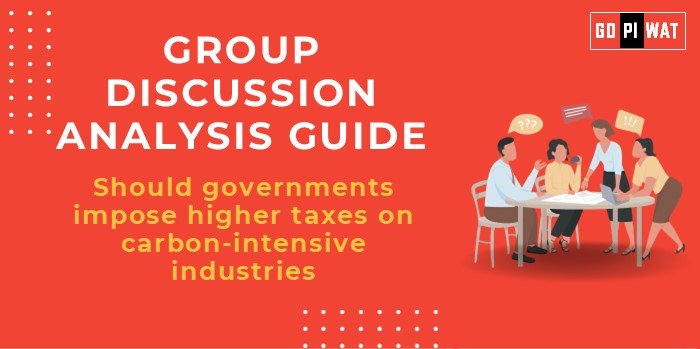📋 GROUP DISCUSSION (GD) ANALYSIS GUIDE
🌍 Introduction to the Topic
Opening Context: Climate change has emerged as a pressing global concern, necessitating urgent action to mitigate its effects. One significant approach involves penalizing high-carbon industries through increased taxes to reduce emissions.
Topic Background: The idea of taxing carbon-intensive industries stems from the polluter-pays principle, where those contributing the most to environmental degradation are held accountable. This mechanism is currently employed in varying degrees worldwide, with notable examples in the European Union and Canada.
📊 Quick Facts and Key Statistics
- Global CO2 Emissions: 36.8 billion metric tons in 2022, primarily from industrial sources (IEA).
- Carbon Pricing: Over 60 jurisdictions globally have implemented carbon pricing initiatives (World Bank, 2023).
- India’s Emissions: Third largest emitter globally, with 2.7 billion metric tons annually.
- Economic Impact: The EU’s carbon tax has contributed to a 12% decrease in emissions since its implementation in 2005.
👥 Stakeholders and Their Roles
- Governments: Formulate and implement taxation policies.
- Industries: Adapt operations to comply with emission norms or pay penalties.
- Environmental Groups: Advocate for stricter policies to curb industrial emissions.
- Citizens: Support sustainable practices while facing potential cost pass-throughs.
🏆 Achievements and Challenges
🎯 Achievements:
- Reduction in Emissions: European countries have significantly reduced industrial emissions through taxation.
- Innovation Drive: Carbon taxes spur innovation in renewable energy and green technologies.
- Revenue Generation: Funds from taxes can support climate mitigation programs.
⚠️ Challenges:
- Economic Burden: Increased costs can adversely affect small and medium enterprises (SMEs).
- Global Disparity: Unequal application of carbon taxes may encourage carbon leakage, shifting industries to countries with lax regulations.
- Public Resistance: High taxation can lead to social and political unrest, as seen with France’s “Yellow Vest” movement.
📚 Structured Arguments for Discussion
- Supporting Stance: “Higher taxes on carbon-intensive industries are essential to drive innovation and meet global climate targets.”
- Opposing Stance: “Carbon taxes disproportionately affect developing economies and increase costs for end consumers.”
- Balanced Perspective: “While carbon taxes can reduce emissions, policies must balance economic impacts and promote equitable growth.”
💡 Effective Discussion Approaches
- Opening Approaches:
- “Carbon taxes have demonstrated success in reducing emissions in Europe. Could this be a viable global solution?”
- “The need for innovation in green technology necessitates a financial push. Are carbon taxes the answer?”
- Counter-Argument Handling:
- Example: “Addressing the concern about economic burdens, governments could subsidize green energy transitions for industries.”
🧩 Strategic Analysis of Strengths and Weaknesses
- Strengths: Reduced emissions, funding for green initiatives.
- Weaknesses: Risk of carbon leakage, uneven global enforcement.
- Opportunities: Global collaboration, technological advancement.
- Threats: Economic backlash, geopolitical tensions over carbon trade policies.
🎓 Connecting with B-School Applications
- Real-World Applications: Analyze carbon pricing models in sustainability projects or case competitions.
- Sample Interview Questions:
- “How do carbon taxes align with sustainable development goals?”
- “Evaluate the economic feasibility of implementing global carbon tax policies.”
- Insights for B-School Students: Study the interplay between environmental policies and economic frameworks for project and internship ideas.


